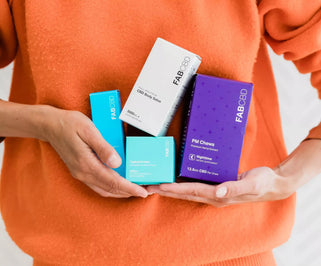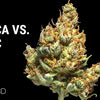Indica vs Sativa: Physical Appearance

Both plants have distinct appearances. For example, cannabis indica plants are shorter than cannabis sativa plants. They have a woody stalk and grow faster than sativa plants, whereas sativa grows slower and has a more fibrous stem. While there is a bit of an argument within the cannabis world as to what causes the plants to have different appearances, some researchers think that the way humans bred assorted plant varieties caused the variations, while others think that it was due to the plants’ geographic location and the ways in which they adapted and evolved naturally over time.
Cannabinoid Components
CBD, or cannabidiol, and THC, or tetrahydrocannabinol, are two of the main cannabinoids in the hemp and marijuana plants. Along with terpenes and phytonutrients, they are two out of over 100 other cannabinoids in the plants. In fact, researchers have found at least 144 different cannabinoids thus far. CBD and THC affect the body differently, and contrary to popular belief, learning whether a plant is indica or sativa will not give much information as to how much of the two cannabinoids it contains. Also, while the marijuana plant naturally has large amounts of THC, the hemp plant is bred to have low levels of that cannabinoid. This is why the 2018 Farm Bill made hemp-derived CBD products legal throughout the United States. CBD products made from hemp have 0.3% or less THC, and therefore cannot cause any euphoric “high” sensations.
Cannabis Indica
The indica plant has its origins in the Middle East — specifically in places like Pakistan, Tibet, and Afghanistan. The plant typically has higher CBD amounts than the sativa plant. However, the CBD to THC ratio is extremely close to 1:1. Most cannabis consumers have an understanding that indica plants create feelings of calm and relaxation. However, because there are many different variations of both the indica and the sativa plant, scientists believe that people should not generalize the effects that these plants create.
Cannabis Sativa
The sativa plant calls warmer regions of the world like Southeast Asia and Central and South America home. Most people believe that the plant causes people to feel energized and creative. The scientific community, however, cannot confirm claims of how the plant makes people feel due to the fact that some sativa plants can be energizing while others may not be. Sativa plants tend to have higher levels of THC over CBD.
Why Names are Important
CBD products can be derived from hemp or from marijuana. Therefore, having a strong understanding of cannabis nomenclature, or name, and the plant’s chemical makeup is pivotal in making an informed choice about CBD. When we say cannabis, we are referring to the genus, or class, of the plant. Additionally, the cannabis plant has three species: sativa, indica, and ruderalis. While some people may think that hemp is a different species of cannabis, it is not. Hemp is, in fact, a sativa species, and marijuana can be either indica, sativa, or ruderalis.

The three species classifications were created to help separate intoxicating cannabis from non-intoxicating cannabis. If all of this information is too much to remember, then simply keep in mind that cannabis is the mother plant and that hemp and marijuana are members of that plant class, or genus. For example, hemp is a cannabis plant that is commercially grown for its stalks, flowers, and seeds, while marijuana is a cannabis plant that’s grown for its euphoric and psychoactive properties, and for its flowers that contain a wealth of cannabinoids. Having said that, hemp contains high amounts of CBD and low amounts of THC, while marijuana naturally can have much higher amounts of THC that make it illegal under the 2018 Farm Bill.
Important Differences that Set Hemp and Marijuana Apart
When it comes to telling hemp and marijuana apart, there are some notable differences that people should be aware of.
Marijuana
- Can have more than 0.3% THC in it
- Can cause a euphoric “high” sensation
- Is only medically or recreationally legal in some states
- Can be purchased at licensed stores in states where it is legal
Hemp
- Must have less than 0.3% THC by federal law
- Will not cause anyone to get “high”
- Federally legal under the 2018 Farm Bill
- Can be purchased online as well as in brick and mortar locations
- Is also used to make clothes, food, textiles, and more
A Word About Legality
Under the 2018 Farm Bill, all hemp-based CBD products are legal across the United States provided they contain 0.3% or less THC. CBD products that are made from marijuana have well over that THC amount. These types of products are only legal in states where medical or recreational marijuana is legal. Even though hemp-derived CBD is legal in the US, each state may have different laws regarding this type of CBD. Therefore, it’s best to play it safe and look into the laws that your home state has on the books regarding hemp-derived CBD. Furthermore, if you’re thinking about traveling and want to bring your CBD along with you, it’s best if you also look into the laws of the states you’ll be traveling through as well as the laws of your destination state.
Final Thoughts on Indica vs Sativa
Federally legal CBD products sold by reputable brands are all hemp-derived and will not get you “high” in any way. There are, however, states where marijuana-based products are legal for either recreational use, medical use, or both. These products will have well over the 0.3% federal legal limit of THC, as the marijuana plant naturally contains higher levels of the cannabinoid. It’s important to remember that both hemp and marijuana are members of the cannabis genus. And while hemp only belongs to the cannabis sativa species, marijuana can span both the cannabis indica species and the cannabis sativa species. Even though hemp and marijuana both come from cannabis sativa and have a lot of the similar traits, there are key differences that functionally set them apart. So now, keeping all of this in mind, you can confidently go forth and make the best decision as to which CBD products will be best for your health goals and wellness needs.







